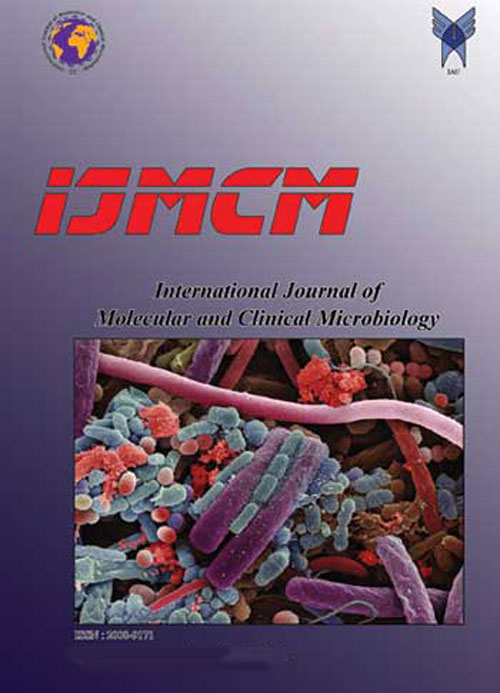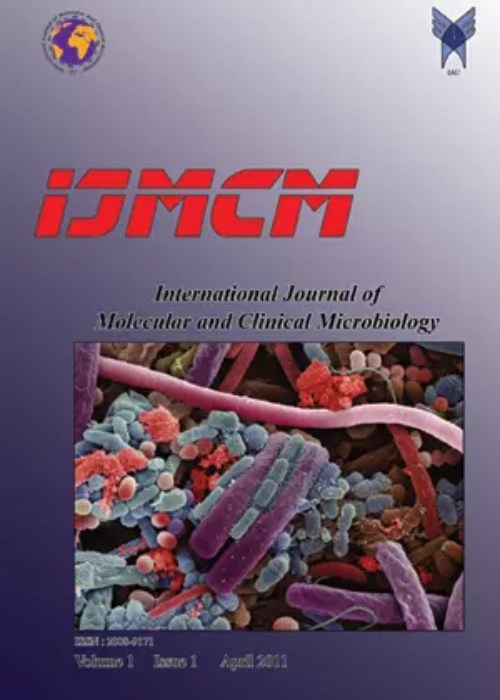فهرست مطالب

International Journal of Molecular and Clinical Microbiology
Volume:3 Issue: 2, Summer and Autumn 2013
- تاریخ انتشار: 1392/07/27
- تعداد عناوین: 10
-
-
Pages 280-284Antibiotic resistance is a public concern, worldwide. The purpose of this study was to survey the antibiotic susceptibility pattern in the microorganisms isolated from the clinical samples in Shahid Faghihi hospital of Shiraz, Iran. In this study, the microorganisms were isolated from the blood, bone marrow, pleural fluid, CSF and Vaginal discharge. Antibiotic susceptibility test was performed by the disk diffusion method according to Clinical and Laboratory Standards Institute (CLSI) standards. Out of 1344 samples, 306 (22.7%) various organisms were obtained. The highest and lowest isolates were related to blood (94.8%) and bone marrow (1.2%), respectively. Among all isolates, Staphylococcus aureus (32.6%) was the most common bacterium. Escherichia coli with 20.9% and Staphylococcus aureus with 64.9% were the most common Gram-negative and Gram-positive isolated bacteria, respectively. Antibiotic susctibility test results also showed that the highest and lowest resistances were related to Acinetobacter and Salmonella, respectively. Awareness of the antibiotic resistance can lead to proper administration of antibiotics in treating of bacterial infections and preventing antibiotic resistance.Keywords: Antibiotic Susceptibility, Clinical samples, Microorganisms, Iran
-
Pages 285-288Today, it has been confirmed that the viral infections play an important role in premature delivery and abortion. This study was carried out to determine the frequency rate of papilloma virus types 16 and 18 in pregnant women and their relationship with premature delivery and abortion. In this study, vaginal secretions were collected from pregnant women who had been referred to the women clinics in Tonekabon, a city in North of Iran. The samples were used to amplify E6 gene of papilloma virus through Polymerase Chain Reaction method. The results were analyzed by χ2 statistical test. Of 47 tested samples, 14 cases were infected with type 16 papilloma virus (HPV16) (29.78%), while 3 cases were infected with type 18 papilloma virus (HPV18) (6.38%). Papilloma virus infection had no significant relationship with abortion and premature delivery. Considering the obtained findings, it appears that a high percentage of the study population was infected with HPV16 virus. Therefore, risk of affliction with abortion and premature delivery can be decreased up to a limit in this region by screening before pregnancy.Keywords: Human papilloma virus, premature delivery, Polymerase Chain Reaction (PCR)
-
Pages 289-294Antibiotics are the best known products of actinomycete. Over 5,000 antibiotics have been identified from the cultures of Gram positive and Gram-negative organisms, and filamentous fungi, but only about 100 antibiotics have commercially been used to treat human, animal and plant diseases. The genus, Streptomycete, is responsible for the formation of more than 60% of known antibiotics. Bacterial urinary tract infections are frequent in the outpatient as well as in the nosocomial setting. The common bacteria from UTIs were isolated from hospital and laboratory samples. The present study was designed to isolate Gram-negative bacteria from urinary tract infections and evaluate Streptomyces gresiofuscus PTCC1628 antimicrobial activity against pathogenic bacteria. Bacterial isolates were identified as Acinetobater spp. and Pseudomonas aeruginosa. The antimicrobial activity was examined by the agar Well diffusion method. The cell free supernatants of the S.gresiofuscus were able to inhibit the growth of all human pathogens (Acinetobacter spp. and P.aeruginosa) isolated in this study in Well diffusion method. The isolates also showed very promising activities against multi drug resistant human pathogens. Concentrations of produced compounds by S.griseofuscus PTCC1628 were determined by GC-MS method.Keywords: S. griseofuscus, Urinary Tract Infections, Antagonistic Activity
-
Pages 295-299Alkaline phosphatase (ortho phosphate, monoester hydrolase phosphoinositide E. C. 3.1.3.1) is a non-specific metalloproteinase enzyme that is located inside periplasmic space of bacteria. This enzyme is used to measure freshwater sediment in genetic engineering for cleaning water. Isolation and molecular identification of the bacteria producing alkaline phosphatase and comparison of its production rate in samples collected from different environmental sources including soil, wastewater and yogurt were the objectives of this study. Different environmental samples including soil, wastewater, stool and dairy products were cultured on the specific medium of phenolphthalein phosphate. Then, the bacteria producing the enzyme were isolated and identified based on the colony morphology, biochemical tests and finally PCT test and ribotyping. After the incubation, only the medium cultured with wastewater showed colonies that were discolored and pinkish. BLAST results of the samples confirmed the existence of Enterococcus durans, Shewanella putrefaciens and Shewanella xiamenensis; Shewanella putrefaciens with the highest concentration rate (87.48 u/l) was selected as the most superior strain. Investigating the enzyme concentration using a spectrophotometer at wavelength of 405 nm determined that the wastewater mediums were the only medium has potential to produce alkaline phosphatase enzyme among environmental sources of soil, wastewater, stool and yogurt. Other environmental samples did not show any potential for enzyme production.Keywords: alkaline phosphatase, environmental sources, isolation of bacteria
-
Pages 300-302Leishmania infantum, an etiologic agent of zoonotic visceral leishmaniasis (VL), is spreading in Iran. Dogs are the main reservoirs but L.infantum has been detected in jackals, foxes and wild rodents too. Despite high number of rodents in the world, the exact role of them in epidemiology of VL is not clear. In recent years the number of sporadic cases of dogs and humans VL has been increased in arid and semi-arid areas of Golestan province. The aim of this study was to detect L.infantum antibody in wild rodents of Turkemen Sahra district of Golestan province. 75 rodents were randomly trapped from 8 areas and after identification of the genus and species, blood was collected by cardiac puncture. Indirect immunofluorescence antibody test (IFAT) was performed on serum samples of captured rodents. % 8 of serum samples which belonged to Mus musculus population were positive. Results of current study highlight the possible role of wild rodents in the spreading of the L.infantum in ecosystem. More epidemiological and molecular study is recommended to imagine the exact role of wild rodents in life cycle of L.infuntum in Golestan province.Keywords: Wild Rodent, Leishmania infuntum, IFAT, Golestan province
-
Pages 303-309Candida exists as a normal flora on skin and mucosa. The prevalence of Candida-induced infections specially mucosal and vaginal infections have been raised in the world in last decade due to increase in predisposing factors. C.albicans is the major etiological agent of candidiasis, but infections due to other species have been increasing. The aim of this study was to determine Candida species by using polymerase chain reaction (PCR) in patient with oral and vulvovaginal candidiasis that referred to clinics of Babol University of Medical Sciences, Babol, Iran. Sixty clinical samples were collected from mouth (no= 29) and vagina (no= 31). Identification of Candida species was done by using a combination of conventional and PCR methods. Germ tube and vesicle (chlamidoconidia) were seen in 43(71.67%) and 42(75%) of Candida isolates, respectively. Assimilation of sugars and Gel electrophoresis of PCR products showed that 78.34% and 75% of isolates were C.albicans, respectively, followed by C.parapsilosis, C.guilliermondii, C.tropicalis and C.glabrata. According to our results, C.albicans was the major causative agent in mouth, and also in vulvovaginal candidiasis. We concluded that Candida spp. is prevalent in mouth and vagina, indicating the necessity for preventing candidiasis by using some antifungal drugs.Keywords: Candida, Mouth, Vagina, PCR
-
Pages 310-314Some N -acyl-N''-aryl thiourea derivatives 4(a-f) have been prepared by the reaction of acyl halides ammonium thiocyanate and aryl amines. The structures of synthesized compounds have been characterized by IR, 1HNMR spectral studies. The synthesized compounds 5(a-f) have been screened for antibacterial activity. The effect of the structure of the investigated compounds on the antibacterial activity is discussed.Keywords: Green chemistry, Thiourea derivatives, Antibacterial activity
-
Pages 315-319BK virus (BKV) is a polyomavirus with seroprevalence in adults, ranging from 60 to 100%. It is considered as usual cause of renal dysfunction after the allograft renal transplantation nephropathy. Potent immunosuppressive therapy in kidney transplantation can lower the rate of acute rejection. Therefore, untreated BKV infections lead to kidney allograft dysfunction or loss. In order to estimate the difference, this study investigated the BKV in urine samples of kidney transplant patients. In this study, we used 220 urine samples from allograft recipients in the time period of 2010-2013. Then, the 287 bp typing region and the PCR increased from the urinary DNA. The PCR products were digested by three limitation enzymes, namely AluI, Cfr13I and RsaI to determine the BKV subtypes.The BKV subtypes are common in the city of Esfahan, Iran. This research showed that 102 (75%) samples were infected by BKV type I. 7 (5%) and BKV subtypes II, 5 (4%) III, and 22 (16%) IV were found in our patients. On the other hand, mixed infections did not clear in the recipients. Our findings showed that BKV replication might occur after kidney transplantation and through the early hours. BKV types II, III and IV are brand new in Iran and previously were not apparent in samples of urine in different kidney transplant patients.Keywords: BKV, BKVAN, PCR, BKV subtype, subgroup, Polyomavirus, immune suppressors, viruria, nephropathy
-
Pages 320-324Candida albicans is an opportunistic fungal pathogen found as mycoflora in the human body surfaces. Sevral genes play a crucial rule in its virulence including Hwp1 (hyphal wall protein 1), BCR1 and ALS gene family. Hwp1 gene is a responsible for coding a cell surface protein, which mediates biofilm formation in candida albicans. Here we investigated the presence of the HWP1gene was characterised among Candida albicans isolates in women with recurrent vaginal canididasis and further we studies its role in cell adherence. We used 50 Candida albicans clinical isolates resistant to Fluconazole. RNA (of samples were extracted using glass bead and lysis buffer and cDNA was synthesized using reverse transcriptase enzyme. Expression of (HWP1) gene was analysed using reverse transcriptase-plolymerase chain reaction (RT-PCR). The ability of adherence of the isolates with or without the expression of HWP1 were characterized using Hela cells. Statistical analysis were performed using t-test and two-way ANOVA SPSS software. Our results showed that the HWP1 gene were present in 47 samples (94%) out of 50 isolates, 27 samples (57%) had expression of HWP1. The result of adherence assay revealed that the isolates with the expression of HWP1 gene and control isolates was statistically different (p<0.05). In conclusion, the isolates with the expression of HWP1 gene has the higher ability to adhere the epithelial mucosal cell surface. Our data support a positive correlation between the expression of HWP1 gene and the ability of adherence to epithelial cells.Keywords: Candida albicans, vaginal candidiasis, Hwp1, adherence
-
Pages 325-333Optimization of the fermentation medium for maximum alkaline protease production was carried out. Fifteen positive isolates were examined for their extent of alkaline protease production. The most potent producer was identified as Bacillus sp. The solid substrate screening showed that the combination of wheat straw and bean husk was the best one. The initial screening by using Plackett–Burman’s design demonstrated that among the tested factors, casein, ammonium sulphate and pepton as the nitrogen sources and glucose, lactose and sucrose as carbon sources, glucose and casein significantly (P < 0.05) enhanced the protease production in combinatory solid state fermentation (SSF). Further optimization of protease production by Bacillus sp. strain k7 on different factors such as incubation time (84 h), inoculums size (64%), initial moisture content (97%), buffer volume (4.9%) in SSF by applying RSM was achieved.Keywords: Alkaline protease, Optimization, Bacillus sp., Solid state fermentation


